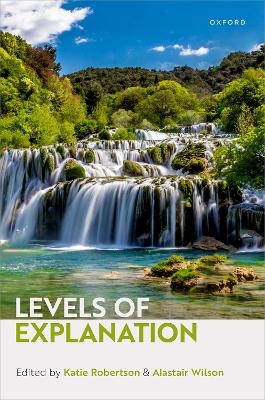
Levels of Explanation
Oxford University Press (Verlag)
978-0-19-286294-5 (ISBN)
This is an open access title available under the terms of a CC BY-NC-ND 4.0 International licence. It is free to read at Oxford Scholarship Online and offered as a free PDF download from OUP and selected open access locations.
The different sciences furnish us with a wide variety of explanations: some work at macroscopic scales, some work at microscopic scales, and some operate across different levels. How do these different explanatory levels relate to one another, and what is an explanatory level in the first place? Over the last 50 years, more and more philosophers--both reductionists and anti-reductionists--no longer subscribe to the idea that the best explanation resides at the fundamental physical level. New challenges arise from the success of scientific explanations employing multi-level models which mix levels of explanation, from distinctive differences between levels structures in biology, cognitive science, and social science, from the apparently radical reimagining of the explanatory role of spacetime in our current best theories of fundamental physics, and from the enduring mystery of how higher-level explanations are possible in the first place. These questions naturally connect to classic philosophical ways of thinking about the relationships between levels: reduction, emergence, and fundamentality. This volume presents a snapshot of cutting-edge research on explanatory levels, from their conceptual foundations to the details of how they are used in scientific practice.
Katie Robertson is Lecturer in Philosophy at the University of Stirling. After completing the BPhil in Philosophy in Oxford, she did her PhD in Cambridge on the philosophy of thermal physics. She was then a postdoc with the FraMEPhys project at the University of Birmingham, before being awarded a Leverhulme Early Career Fellowship exploring the relationship between thermodynamics and black holes. Her research has focused on questions about how different sciences, or levels, fit together. She has also worked on how non-fundamental theories such as thermodynamics and their quantities like entropy are related to more fundamental quantities in quantum mechanics. Alastair Wilson is Professor of Philosophy at the University of Leeds, specializing in metaphysics, philosophy of science (especially physics), and epistemology. Before joining Leeds, he spent 11 years at the University of Birmingham and 18 months as a postdoc at Monash University. His doctoral thesis was on the metaphysics of Everettian (many-worlds) quantum mechanics; this line of thought culminated in his book The Nature of Contingency: Quantum Physics as Modal Realism (OUP, 2020). More recently he has focused on explanation and dependence in physics; he has also worked on grounding, laws of nature, chance, and the epistemology of self-locating belief.
Katie Robertson and Alastair Wilson: Introduction: Levels of Explanation
Part I: Foundations of Explanatory Levels
1: Christian List: Levels of Description and Levels of Reality: A General Framework
2: Angela Potochnik: Antireductionism Has Outgrown Levels
3: Alexander Franklin: How the Reductionist Should Respond to the Multiscale Argument, and What This Tells Us About Levels
Part II: Levels of Explanation in Causal Modelling
4: Brad Weslake: Exclusion Excluded
5: Vera Hoffmann-Kolss: Interventionist Causal Exclusion and the Challenge of Mixed Models
6: David Yates: From Multilevel Explanation to Downward Causation
Part III: Levels of Explanation in Higher-Level Sciences
7: William Bechtel: Explanatory Levels in Living Organisms
8: Mazviita Chirimuuta: From Analogies to Levels of Abstraction in Cognitive Neuroscience
9: Harold Kincaid: Messy but Real Levels in the Social Sciences
Part IV: Levels of Explanation in Physics
10: Eleanor Knox: Levels Worth Having: A View from Physics
11: Karen Crowther: Levels of Fundamentality in the Metaphysics of Physics
12: Kerry McKenzie: No Grounds for Effective Theories
Part V: Levels of Explanation in Mathematics and Metaphysics
13: Carolin Antos and Mark Colyvan: Explanation in Descriptive Set Theory
14: Elanor Taylor: A Dormitive Virtue Puzzle
15: Nina Emery: The Explanatory Role Argument and the Metaphysics of Deterministic Chance
Part VI: How are Explanatory Levels Possible?
16: Harjit Bhogal: Why Are There High-Level Regularities?
17: Michael Strevens: Why High-Level Explanations Exist
18: Michael Townsen Hicks: A Democracy of Laws
| Erscheint lt. Verlag | 19.12.2024 |
|---|---|
| Zusatzinfo | 28 figures |
| Verlagsort | Oxford |
| Sprache | englisch |
| Maße | 156 x 234 mm |
| Themenwelt | Geisteswissenschaften ► Philosophie ► Metaphysik / Ontologie |
| Mathematik / Informatik ► Mathematik | |
| Naturwissenschaften | |
| ISBN-10 | 0-19-286294-4 / 0192862944 |
| ISBN-13 | 978-0-19-286294-5 / 9780192862945 |
| Zustand | Neuware |
| Informationen gemäß Produktsicherheitsverordnung (GPSR) | |
| Haben Sie eine Frage zum Produkt? |
aus dem Bereich


